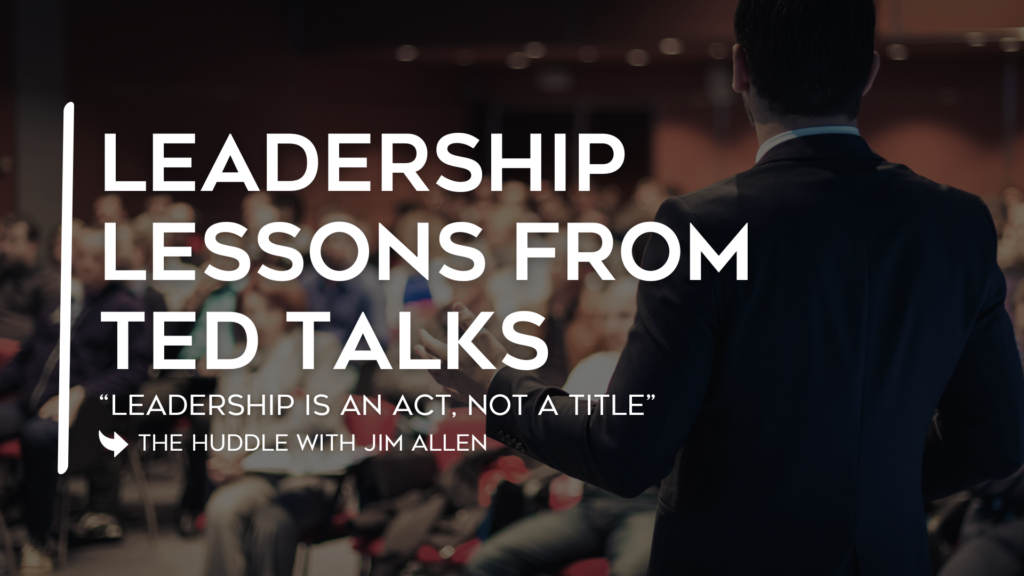Leadership lessons to glean from TED talks



Since 1984, TED, short for Technology, Entertainment, and Design, has been giving people across different cultures and disciplines a platform to deepen our understanding and connection with the world around us. TED Talks are readily available on YouTube, and thanks to how accessible the organization has made these talks, it’s possible to find incredible ideas that can change the way you see the world.
TED has some amazing talks about leadership that are so insightful and empowering they might just sway you in your daily actions. I encourage you to always be curious. And I encourage you to look for ways you can keep learning and improve every day. One of the simple ways you can do that is to listen to TED talks and see what you can take away.
Many of these talks take less than 10 minutes to get through, yet they can lead to a lifetime of growth. The following are just a few of the great leadership talks I’ve found and the lessons I’ve learned from a bit of listening.
Leadership is an act, not a title
In his talk, “You don’t have to be a CEO to be a leader,” Alex Budak introduces the concept of micro-leadership. Budak, who teaches at the University of California Berkeley and is a co-founder of the crowdfunding platform StartSomeGood, explains that micro-leadership is taking the opportunity to practice leadership whether you have the title of “leader” or not.
Budak says to do three specific things to make a difference: give yourself permission to act, go beyond yourself to serve others, and take action over and over again. One of the things I love about this talk is how simple the concept is. Budak says leadership is about acting consciously and regularly and that it’s this practice over time that results in true leadership. The point is that it doesn’t take a certain personality or even a big title. It just takes thoughtful practice and consistency. It’s something you can start doing today.
Inspirational leadership requires a ‘why’
Author and speaker Simon Sinek says great leaders work from the inside out in his talk, “How great leaders inspire action.” This talk is over 14 years old, yet it still resonates today and has millions of views, and that’s for good reason. He explores why people get inspired to follow what we ultimately deem to be great leaders. His examples include Martin Luther King Jr., the Wright Brothers, and Apple computers. Just what made them stand apart?
“People don’t buy what you do; they buy why you do it,” he says. He further explains that your “why” not only proves what you believe but when other people connect with your why, they are motivated to believe in your how and what you have to offer. Sinek further explains that those who believe in you tend to show up for themselves, but it’s your inspiration that makes them want to follow. He says that leaders hold power but “those who lead” because they inspire us. And if you ask me, that’s real power.
Great leaders empower teams to be part of solutions
Jim Whitehurst was the Chief Operating Officer of Delta before joining fellow Triangle company Red Hat, where he believed he had been recruited because of his ability to hone his management structure. He quickly learned that leadership isn’t the person who knows the most. His talk, “What I learned from giving up everything I knew as a leader,” explains how he learned his role as a leader needed to empower Red Hat’s team to develop innovative solutions.
Whitehurst explains that “leadership is about creating context to allow the best ideas to emerge within your organization.” He further says that it’s important to allow for criticism and encourage open communication to create real innovation within your team. Keep in mind it’s hard work to consistently open yourself up to criticism, especially if you’re at the top of the chain in your company. But Whitehurst explains from first-hand experience that letting go of the traditional top-down management role is critical, and to give the entire team everything they need to do their best work. That’s where real innovation happens.
Leadership requires taking a leap
Roselinde Torre has traveled the world to study leaders, and as the senior partner and managing director at the consulting firm BCG, she has specific advice on what she has seen from the best leaders out there. In her talk, “What it takes to be a great leader,” Torre is adamant that leaders must let go of traditional ideas of success, which can stunt growth.
Torre asks three important questions for leaders to reflect upon. The first question is, “Where are you looking to anticipate change?” Leaders must be able to shape their own future and success, not be reactive to what’s happening around them. The second question is, “What is the diversity measure of your network?” The more diverse your network, the more new ideas and solutions are brought to the table, she says. And finally, she asks, “Are you courageous enough to abandon the past?” Great leaders must be willing to take a giant leap to prepare for the realities of today and the unknowns of tomorrow. As scary as that can seem, it’s critical to growth.
What can you do to become a better leader?
I love looking for ways to challenge the status quo. I encourage you to listen to these talks and then ask what you’re doing to be a great leader. Do you have other concepts to share? I’d love to hear them, so feel free to comment below and give me your own thoughts on great leadership.
Jim Allen is a business leader and entrepreneur who has built one of the top-producing real estate groups in the Triangle. He is President of The Jim Allen Group, which is consistently named one of the top real estate teams in North Carolina and even North America.


